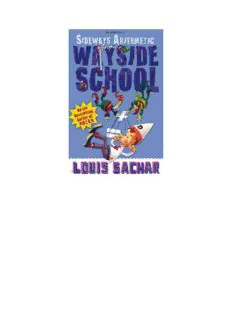
Sideways Arithmetic from Wayside School (UK) PDF
Preview Sideways Arithmetic from Wayside School (UK)
g g To Dan, who taught me to play chess when I was six years old g . Contents . Chapter 1 Chapter 2 Chapter 3 Chapter 4 Chapter 5 Chapter 6 Chapter 7 Chapter 8 Chapter 9 Hints Answers About Louis Sachar Imprint g Chapter 1 Spelling Sue was very excited to be at Wayside School in Mrs. Jewls’s class! She was surrounded by all the kids she had read about in her favorite book, Sideways Stories from Wayside School. She sat next to Rondi, who really was missing her two front teeth, just like it said in the book. “Everyone take out your spelling books,” said Mrs. Jewls. “It’s time for arithmetic.” “Huh?” said Sue. She didn’t know why you’d need spelling books to do arithmetic. Mrs. Jewls wrote the first problem on the blackboard. PROBLEM 1 g g “How much is elf plus elf?” asked Mrs. Jewls. They all picked up their pencils and busily tried to figure out the answer. Allison raised her hand. “Yes, Allison,” said Mrs. Jewls. “Fool!” Allison declared. Mrs. Jewls smiled. “Very good,” she said and she wrote the answer on the blackboard under the problem. g g “How foolish,” said Sue. Yet it wasn’t foolish at all. Each letter in the above problem represents a different number between 0 and 9. The letters remain constant within the problem. For example, if f represented the number 8, then every f in the problem would be replaced by the number 8. But f isn’t 8. Can you figure out what number each letter represents? g e = ?llllf = ?lllll = ?llllo = ? g An explanation of how to solve this type of problem follows. g Explanation You don’t start at the top. You don’t start at the bottom. You have to look at the whole problem altogether. Then, like a detective, you search for clues. g g The clue to the first problem is the letter f in fool. g g Ignoring the first two columns for now, you see that: g g Therefore f has to represent the number 1. When adding two numbers, the only number you can ever carry is the number 1. You now replace all the f’s in the problem with the number 1. g g Since there are both letters and numbers, be careful that you don’t confuse the number 1 with the letter I, or the number 0 with the letter o. Now, looking at the first column you see that: g g Since you know that 1 + 1 = 2, you can now replace all the letter l’s in the problem with the number 2. g g In the second column you see that 2 + 2 = o. You can now replace all the o’s in the problem with the number 4. g g You now know that e + e = 14. Therefore e must represent the number 7. g g The problem is now complete: g e = 7llllf = 1lllll = 2llllo = 4. g As you can see, when Mrs. Jewls asks, “How much is elf plus elf?” there is no way you can guess the exact answer she is looking for. You have to wait for someone in her class to give the “answer.” Then you can figure out the numerical answer to the problem. So on the next question when Mrs. Jewls asks, “How much is egg plus egg?” you have to wait until the answer is given in class, and then try to solve the problem. PROBLEM 2 Mrs. Jewls wrote another problem on the blackboard. “How much is egg plus egg?” she asked. g g “Scrambled or fried?” asked Ron. “Scrambled,” said Mrs. Jewls. “Yech, I hate eggs,” said John. g g “Do you have pancakes?” asked Leslie. Mrs. Jewls looked annoyed. “Don’t talk with your mouth full,” she scolded her. At last Jason raised his hand. “Egg plus egg equals page,” he announced. g g Sue was very confused. “What page are we on?” she asked. She wasn’t even hungry. Again, each letter represents a different number. This time, what number does each letter represent? g a = ?lllle = ? llllg = ?llllp = ? g An explanation of how to solve this problem follows. g Explanation The clue to the second problem is the letter g. g g In the second column you see that g + g = g. At first you might think that g has to equal 0. But in the first column you see that g + g = e. Since every letter has to represent a different number, both e and g can’t represent 0. If you try different numbers you will find that g has to represent 9. g g Therefore e must represent 8, and the rest of the problem is easily solved. g
